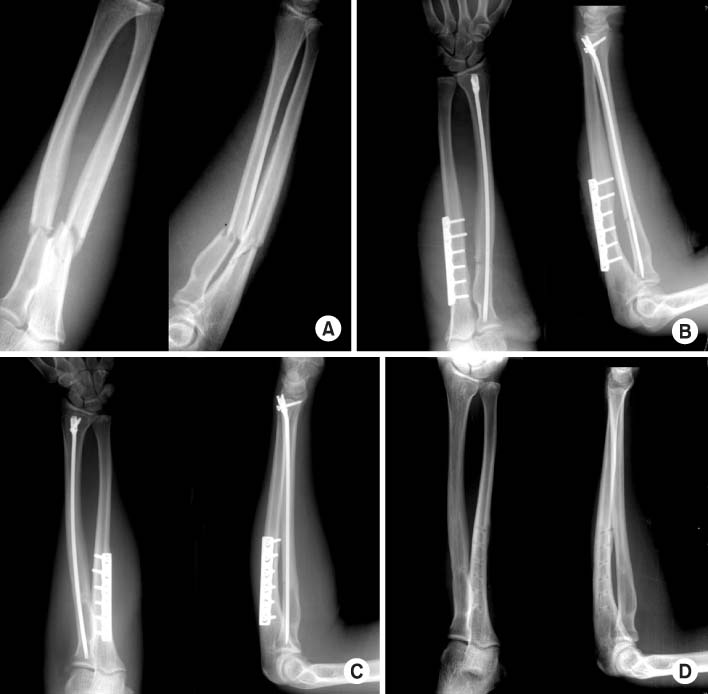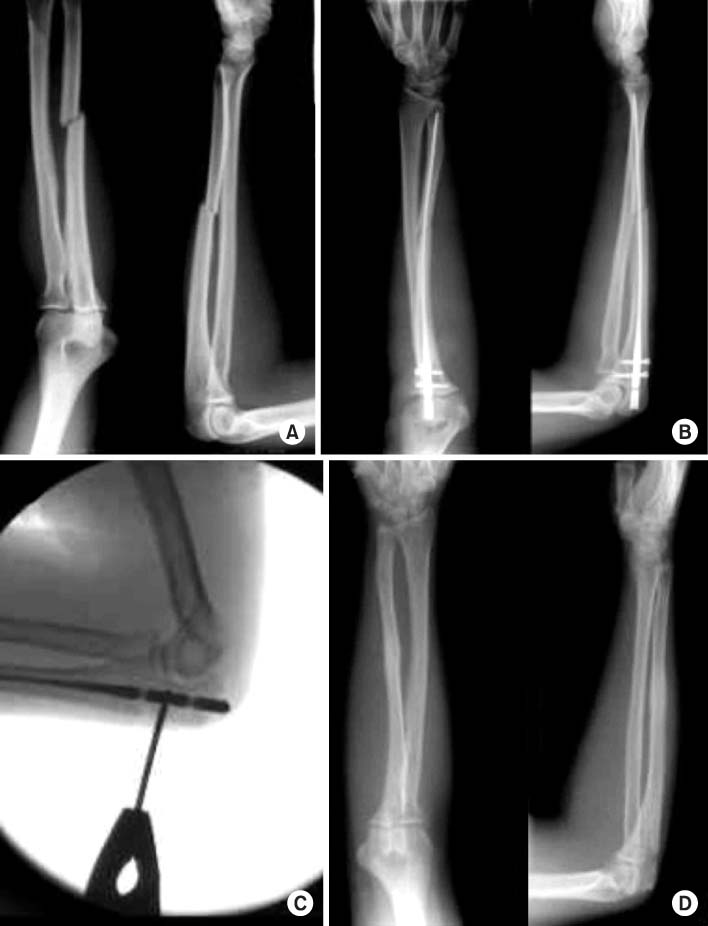J Korean Fract Soc.
2009 Jan;22(1):30-38. 10.12671/jkfs.2009.22.1.30.
Interlocking Intramedullary Nailing of Forearm Shaft Fractures in Adults
- Affiliations
-
- 1Department of Orthopedic Surgery, Sanggye Paik Hospital, College of Medicine, Inje University, Seoul, Korea. shoulder@paik.ac.kr
- KMID: 2183885
- DOI: http://doi.org/10.12671/jkfs.2009.22.1.30
Abstract
- PURPOSE
To evaluate the usefulness of interlocking intramedullary nailing for operative treatment of forearm shaft fractures in adults.
MATERIALS AND METHODS
Thirteen forearm shaft fractures in 12 patients were fixated with 13 Acumed forearm intramedullary rods (ulna: 8, radius: 5). The average age was 36.7 years and mean follow-up period was 15.2 months. The union time was measured when there was no tenderness over the fracture site and the bridging callus was evident in at least two sides of the cortex. The range of motion of the joint and the rotation of the forearm was measured and the functional results were evaluated with Grace and Eversmann's rating system.
RESULTS
Radiologic union was observed at 11.8 weeks postoperatively in 11 cases out of 13. No limitation of motion was observed. Nine had excellent or good functional results. In one Galeazzi fracture, radial shaft became displaced after nailing and should be re-stabilized with plate. Proximal interlocking screws were improperly inserted in one ulnar nail. Implants were removed in 7 cases. Removal guide screw was broken while removing the intramedullary nail in one case of ulnar shaft fracture.
CONCLUSION
Interlocking intramedullay nailing might be a treatment option for the middle 1/3 shaft fractures of the adult forearm bone with favorable results.
Keyword
MeSH Terms
Figure
Cited by 1 articles
-
Comparison of Bending Strength among Plate, Steinmann Pin, and Headless Compression Screw Fixations for Proximal Ulnar Shaft Fracture in Sawbones
Jinyoung Han, Jin Rok Oh, Jaewoong Um
Arch Hand Microsurg. 2020;25(4):267-273. doi: 10.12790/ahm.20.0065.
Reference
-
1. Beaupre GS, Csongradi JJ. Refracture risk after plate removal in the forearm. J Orthop Trauma. 1996; 10:87–92.
Article2. Brumback RJ, Virkus WW. Intramedullary nailing of the femur: reamed versus nonreamed. J Am Acad Orthop Surg. 2000; 8:83–90.
Article3. De Pedro JA, Garcia-Navarrete F, Garcia De, Otero R, Oteo A, Lopez-Duran Stern L. Internal fixation of ulnar fractures by locking nail. Clin Orthop Relat Res. 1992; 283:81–85.4. Finkemeier CG, Schmidt AH, Kyle RF, Templeman DC, Varecka TF. A prospective, randomized study of intramedullary nails inserted with and without reaming for the treatment of open and closed fractures of the tibia shaft. J Orthop Trauma. 2000; 14:187–193.
Article5. Gao H, Luo CF, Zhang CQ, Shi HP, Fan CY, Zen BF. Internal fixation of diaphyseal fractures of the forearm by interlocking intramedullary nail: short-term results in eighteen patients. J Orthop Trauma. 2005; 19:384–391.6. Grace TG, Eversmann WW Jr. Forearm fracture: treatment by rigid fixation with early motion. J Bone Joint Surg Am. 1980; 62:433–438.7. Jones DJ, Henley MB, Schemitsch EH, Tencer AF. A biomechanical comparison of two methods of fixation of fractures of the forearm. J Orthop Trauma. 1995; 9:198–206.
Article8. Kang CN, Kim JO, Kim DW, et al. The operative treatment of the shaft fractures of the forearm bone: operative comparison in intramedullary fixation to plate fixation on treatment of the both forearm bone fracture. J Korean Soc Fract. 1998; 11:63–69.
Article9. Kim KY, Lim MS, Choi SK, Yoon HJ. Treatment of forearm shaft fracture with modified interlocking intramedullary nail. J Korean Fract Soc. 2008; 21:157–164.
Article10. Labosky DA, Cermak MB, Waggy CA. Forearm fracture plates: to remove or not to remove. J Hand Surg Am. 1990; 15:294–301.
Article11. Langkamer VG, Ackroyd CE. Removal of forearm plates. A review of the complications. J Bone Joint Surg Br. 1990; 72:601–604.
Article12. Lee YH, Lee SK, Chung MS, Baek GH, Gong HS, Kim KH. Interlocking contoured intramedullary nail fixation for selected diaphyseal fractures of the forearm in adults. J Bone Joint Surg Am. 2008; 90:1891–1898.
Article13. Matthews LS, Kaufer H, Garver DF, Sonstegard DA. The effect on supination-pronation of angular malalignment of fractures of both bones of the forearm. J Bone Joint Surg. 1982; 64:14–17.
Article14. Rosson JW, Shearer JR. Refracture after the removal of plates from the forearm. An avoidable complication. J Bone Joint Surg Br. 1991; 73:415–417.
Article15. Sage FP, Smith H. Medullary fixation of forearm fractures. J Bone Joint Surg Am. 1957; 39:91–98.
Article16. Sarmiento A, Ebramzadeh E, Brys D, Tarr R. Angular deformities and forearm function. J Orthop Res. 1992; 10:121–133.
Article17. Schemitsch EH, Jones D, Henley MB, Tencer AF. A comparison of malreduction after plate and intramedullary nail fixation of forearm fractures. J Orthop Trauma. 1995; 9:8–16.
Article18. Shin HD, Rhee KJ, Yang JY, Yun SH, Lee MJ. Comparison of clinical results between the plate fixation and intramedullary nailing for the diaphyseal both forearm bone fractures. J Korean Soc Fract. 1999; 12:135–144.
Article19. Stannard JP, Harris HW, McGwin G Jr, Volgas DA, Alonso JE. Intramedullary nailing of humeral shaft fractures with a locking flexible nail. J Bone Joint Surg Am. 2003; 85:2103–2110.
Article20. Street DM. Intramedullary forearm nailing. Clin Orthop Relat Res. 1986; 212:219–230.
Article21. Weckbach A, Blattert TR, Weisser Ch. Interlocking nailing of forearm fractures. Arch Orthop Trauma Surg. 2006; 126:309–315.
Article
- Full Text Links
- Actions
-
Cited
- CITED
-
- Close
- Share
- Similar articles
-
- Interlocking Intramedullary Nailing Versus conventional Kuntscher Intramedullary Nailing for Fracture of the Femoral Shaft
- Interlocking Intramedullary Nailing for the Femoral Shaft Fractures
- The Clinical Results of Unreamed Interlocking Intramedullary Nailing for Tibial Fractures
- Treatment of femoral Shaft Fractures with Static Interlocking Intramedullary Nailing
- Interlocking Intramedullary Nailing in the Treatment of the Tibial Shaft Fractures: Comparative Study between Reamed and Unreamed Nailing





